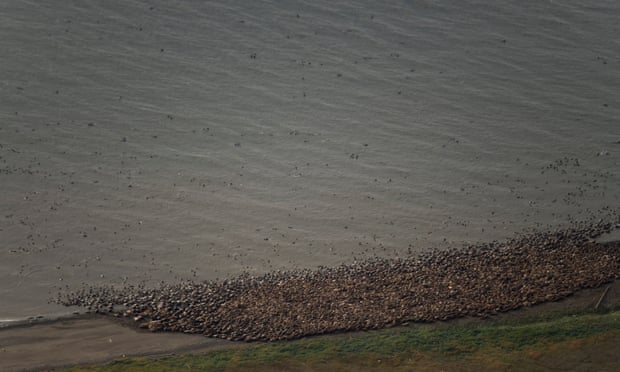Suzanne Goldenberg US environment correspondent
Thursday 27 August 2015
The extreme loss of Arctic sea ice due to climate change is forcing thousands of walruses to crowd ashore on a remote barrier island off Alaska, and threatening their survival.
Barack Obama will be the first US president to visit the Alaskan Arctic on 31 August on a three-day tour to draw attention to the drastic consequences of climate change for the Arctic, such as warming winters and the rapid retreat of sea ice.
The first reported sighting of animals forced to come ashore in the Chukchi Sea was by a photographer on 23 August, and confirmed by villagers in the remote hamlet of Point Lay late on Thursday, the US Fish and Wildlife Service said.
Such landings, forced by the absence of sea ice on which to rest and feed, put the animals at risk of stampede in the limited space of the barrier island.
The animals are easily spooked by aircraft or onlookers, government scientists warned. Trampling deaths are one of the biggest natural risks.
Sea ice cover in the winter months fell to a new low this year because of climate change and abnormal weather patterns.
Some scientists believe the Arctic could be entirely ice-free in the summer months by the 2030s – with profound effects for local indigenous communities that rely on the ice, as well as wildlife that depend on extreme conditions.
Since 2000, the forced migration of walruses and their young to barrier islands such as Point Lay – known as a “haul out” – has become an increasingly regular occurrence, according to US government scientists.
•••••
Last year, as many as 40,000 animals, mainly females and their young, were forced ashore. It was the biggest known haul-out of its kind in the US Arctic, according to government scientists. The Federal Aviation Authority re-routed flights and bush pilots were told to keep their distance to avoid a stampede.
Agency scientists said about 60 young walruses were killed because of crowding and stampedes.
“Walruses often flee haulouts in response to the sight, sound, or odor of humans or machines. Walruses are particularly sensitive to changes in engine noise and are more likely to stampede off beaches when planes turn or fly low overhead,” Andrea Medeiros, a spokeswoman for the fish and wildlife service, said in an email.
•••••
Gary Braasch, an environmental photographer, said he first spotted the walruses coming ashore on the southern end of the barrier island, about two miles from the hamlet of Point Lay, on the evening of 23 August.
•••••


No comments:
Post a Comment